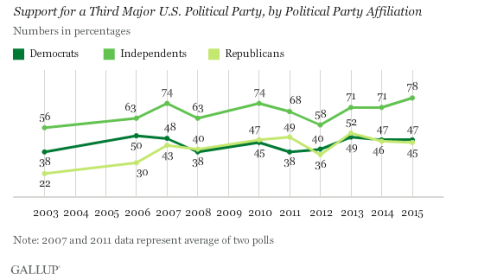Why Do We Only Care About Two Parties?

If you have been following the presidential election lately you might have found yourself in one of two camps. You might have found yourself either becoming frustrated with both candidates and you have decided to vote for a third party candidate; or, you might have found yourself being so frustrated with the system (or the candidates in general) that you don’t think you’ll be voting at all. In either case, this common frustration has left many to wonder – why do we only care about two parties?
Admittedly it does seem a bit anti-democratic to have only two pragmatic options for the “Leader of the Free World.” After all, in other countries there are many political parties, in Germany and Turkey for example. So why does the United States of America have such a straitjacket in their election process? Well, it’s complicated.
In the scientific cannon, very rarely do you establish something called a “law.” A scientific law is something that is has been proven (beyond doubt) to be a causal relationship to better explain the world around us – Newton’s Law of Gravity is an example. Well, as it turns out political science really only has one law (with admittedly some error) and that is one that describes the origins of political parties – Duverger’s Law.
Duverger’s law posits that when a nation has a particular type of election process, political parties will form to be most beneficial to winning that type of election. For example, in Germany and Turkey there are proportional elections where voters select a party that they like and if that group is selected and gets beyond a certain election threshold (say Turkey’s 10% threshold) the party gets a percentage of representation in government. In contrast, the United States has what’s called “First Past the Post” (FPTP) elections where the candidate with 50 +1% of the representatives win the office. This is broken down to each elected office throughout the nation. So what we end up seeing is multiple parties representing the electorate in other countries whereas, in a strategy to win, the United States really only has two main competitors.
Of course there are many third parties, just like there are thousands of presidential candidates, but we narrow it down to only the top competitors before and during the primaries. Many people dislike such restrictions that seem to undermine the well needed nuance and multidimensional framework needed to tackle complex issues of the day. In fact, according to Gallup data from 2003 to 2015 many would support the idea of a third major U.S. political party – even many those aligned with one of the major two parties.

Arguably, the political climate is ripe for such an emergence of an “outsider party.” Yet, it seems as if the American electorate was more comfortable trying to bring in “outsider candidates” into their existing party framework.
There’s much more to be said on this topic (I’ve recommended some books at the bottom of this article) but essentially whether it be elite manipulation, media influences, party power, lobbying, gerrymandering, or political polarization – it is looking as if the two party system is here to stay. But it’s not all that bad.
Political parties offer candidates the resources and support network to become noticed. Political parties also provide the electorate with a surprisingly accurate heuristic for voting. Also no two candidates in a party are the same, so there is a lot of variation within our simplistic party system – just ask any Republican not voting for Trump. Finally, much of the geographical space in America is contested creating “purple” zones of populations that are diverse in representation. For example the visualization of the data received from the 2008 Cooperative Congressional Election Study (CCES) shows that much of America is independent or more “purple” in their political preferences.

What voters are challenged to do is either vote pragmatically or with their ideology. Voting pragmatically means to scale up either candidate and choose the candidate that they feel is better than the other. Voting ideologically is to vote for any candidate on the individual’s principles.
While voting for a third party may seem like “throwing your vote away” in terms of data and political representation it is anything but that. Even voting Republican or Democrat in the hardest of opposite-colored states it is still good practice to vote, it tells our politicians that their area of representation is far more purple than they think. It also tells our representatives that you’re an active voter and an advocate if you dislike something they’re doing. The real case of “throwing your vote away” is when you don’t vote, because then you are giving the message that you don’t care or don’t wish to be acknowledged when it comes time to think about policy implementation.
So whether you vote Democrat or Republican, Green or Libertarian, Tea Party or for any of the many national Socialist parties across the nation, take solace in the fact that the two party system has some up sides. If you are still frustrated, well then you are not alone. As it turns out nations with a FPTP election system have abysmally small voter turnout when compared to similar nations with multi-party systems.
The main book I would recommend for further review on this topic (as it deserves) would be John Aldrich’s “Why Parties?” but also D. Ray (1967) and Easton have both been cited thousands of times for their commentary on the formulation of two party systems.
Image credit goes to “IntelligenceSquared” an organization which promotes constant debates and exchanges in ideas even beyond politics. I am a regular to their website: http://www.intelligencesquaredus.org/